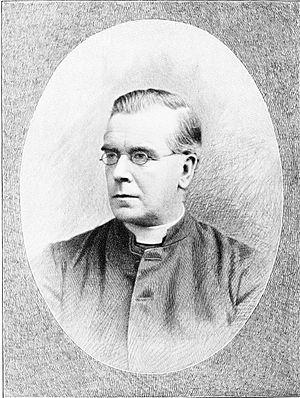Stephen Joseph Perry facts for kids
Quick facts for kids
Rev. Father
Stephen Joseph Perry
S.J.
|
|
|---|---|
 |
|
| Born | 26 August 1833 London, England
|
| Died | 27 December 1889 (aged 56) at sea
|
| Occupation | Priest, Astronomer |
| Known for | Astronomy |
|
Notable work
|
Stonyhurst College Observatory |
| Awards | Fellow of the Royal Society |
Stephen Joseph Perry (born August 26, 1833, in London – died December 27, 1889) was an English priest and astronomer. He was a member of the Jesuits, a Catholic religious order. Perry was well-known for joining many important scientific trips around the world. He was also a Fellow of the Royal Society, a group that promotes science.
Contents
Early Life and Education
Stephen Joseph Perry came from a well-known Catholic family. He first went to school at Gifford Hall. Later, he studied at the Benedictine College in Douai, France. After this, he traveled to Rome to study and become a priest.
In 1853, he decided to join the Society of Jesus, also known as the Jesuits. He began his training at Hodder and then at Beaumont Lodge. He continued his studies in St. Acheul, France, and at Stonyhurst College in England.
A Love for Science
Stephen Perry showed a strong talent for mathematics. Because of this, he was sent to learn from famous mathematicians. He attended lectures by Augustus De Morgan in London. He also studied in Paris with experts like Bertrand and Cauchy.
In 1860, he returned to Stonyhurst College. There, he taught physics and mathematics. He also took charge of the college's observatory, which is a place for observing stars and planets.
Becoming a Priest
In 1863, Perry began studying theology at St. Beuno's College in North Wales. He became a priest in 1866. After his ordination, he went back to his duties at Stonyhurst. He continued his scientific work and teaching there for the rest of his life.
Scientific Expeditions and Discoveries
Father Perry was a very active scientist. He traveled a lot to observe natural events and study Earth's magnetic field.
Magnetic Surveys
With his colleague Father Walter Sidgreaves, Perry conducted surveys of Earth's magnetic field. These surveys helped scientists understand how the magnetic field changes. They explored western France in 1868 and eastern France in 1869. In 1871, they carried out similar work in Belgium.
Observing Solar Eclipses
Stephen Perry led several government expeditions to observe solar eclipses. These are times when the Moon passes in front of the Sun, blocking its light.
- In 1870, he observed an eclipse in Cadiz, Spain.
- He traveled to Carriacou in the West Indies in 1886.
- He was in Moscow in 1887 for another eclipse.
- His final expedition was to the Îles du Salut in 1889.
Studying the Transit of Venus
In 1874, Perry led a team to the Kerguelen Islands in the South Indian Ocean. Their mission was to observe a transit of Venus. This is a rare event where the planet Venus passes directly in front of the Sun. Observing this helps scientists measure distances in space.
While there, he also took many measurements. He determined the exact location of the islands. He also studied the magnetic elements of the area. On his way back, he took more magnetic readings in places like the Cape, Bombay, and Malta. He even wrote a report about the climate of the Kerguelen Islands, which was called "The Isle of Desolation" by Captain Cook.
In 1882, he went with Father Sidgreaves again to observe another transit of Venus in Madagascar. He used this trip to gather more magnetic data.
Work at Stonyhurst Observatory
At Stonyhurst College, Father Perry greatly improved the observatory. He expanded its work in meteorology, which is the study of weather.
In astronomy, he often observed Jupiter's satellites (moons). He also watched stellar occultations, which happen when a star is hidden by another celestial body. He studied comets and meteors too.
Perry was especially interested in solar physics, the study of the Sun. He paid close attention to sun spots and faculae, which are bright areas on the Sun's surface. He developed clever ways to observe these features. Father Perry was the director of the Stonyhurst College Observatory from 1860 to 1863, and again from 1868 until his death.
Final Expedition and Death
Father Perry was very popular as a lecturer, sharing his knowledge with others.
His last expedition was to observe a total solar eclipse in December 1889. This trip took him to the Îles du Salut in French Guiana. While preparing for his observations, Perry became very ill. Despite feeling weak, he managed to observe the eclipse successfully. He completed all his scientific goals.
After the eclipse, his health quickly got worse. He returned to the ship HMS Comus. Five days later, on December 27, 1889, he died at sea. He was buried in the Catholic cemetery in Georgetown, Demerara.
See also
- List of Roman Catholic scientist-clerics

